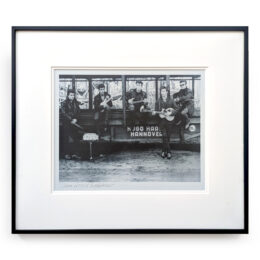

Astrid Kirchherr 20 May 1938 – 12 May 2020) was a German photographer and artist known for her association with the Beatles (along with her friends Klaus Voormann and Jürgen Vollmer) and her photographs of the band’s original members – John Lennon, Paul McCartney, George Harrison, Stuart Sutcliffe and Pete Best – during their early days in Hamburg.
Kirchherr met artist Stuart Sutcliffe in the Kaiserkeller bar in Hamburg in 1960, where Sutcliffe was playing bass with the Beatles, and was later engaged to him, before his death in 1962. Although Kirchherr shot very few photographs after 1967, her early work has been exhibited in Hamburg, Bremen, London, Liverpool, New York City, Washington, D.C., Tokyo, Vienna, and at the Rock ‘n’ Roll Hall of Fame. She published three limited-edition books of photographs.
Kirchherr was born in 1938 in Hamburg, Germany, and was the daughter of a former executive of the German branch of the Ford Motor Company. During World War II, she was evacuated to the safety of the Baltic Sea where she remembered seeing dead bodies on the shore (after the ships Cap Arcona and the SS Deutschland had been bombed and sunk) and the destruction in Hamburg when she returned.
After her graduation, Kirchherr enrolled in the Meisterschule für Mode, Textil, Grafik und Werbung in Hamburg, as she wanted to study fashion design but demonstrated a talent for black-and-white photography. Reinhard Wolf, the school’s main photographic tutor, convinced her to switch courses and promised that he would hire her as his assistant when she graduated. Kirchherr worked for Wolf as his assistant from 1959 until 1963.
In the late 1950s and early 1960s, Kirchherr and her art school friends were involved in the European existentialist movement whose followers were later nicknamed “Exis” by Lennon. In 1995, she told BBC Radio Merseyside: “Our philosophy then, because we were only little kids, was wearing black clothes and going around looking moody. Of course, we had a clue who Jean-Paul Sartre was. We got inspired by all the French artists and writers, because that was the closest we could get. England was so far away, and America was out of the question. So France was the nearest. So we got all the information from France, and we tried to dress like the French existentialists… We wanted to be free, we wanted to be different, and tried to be cool, as we call it now.”